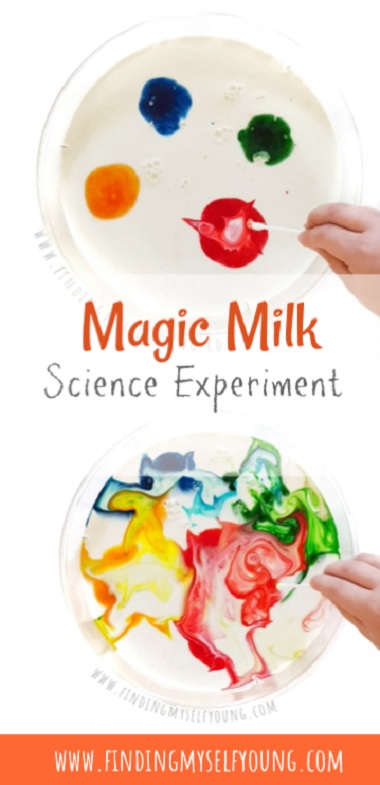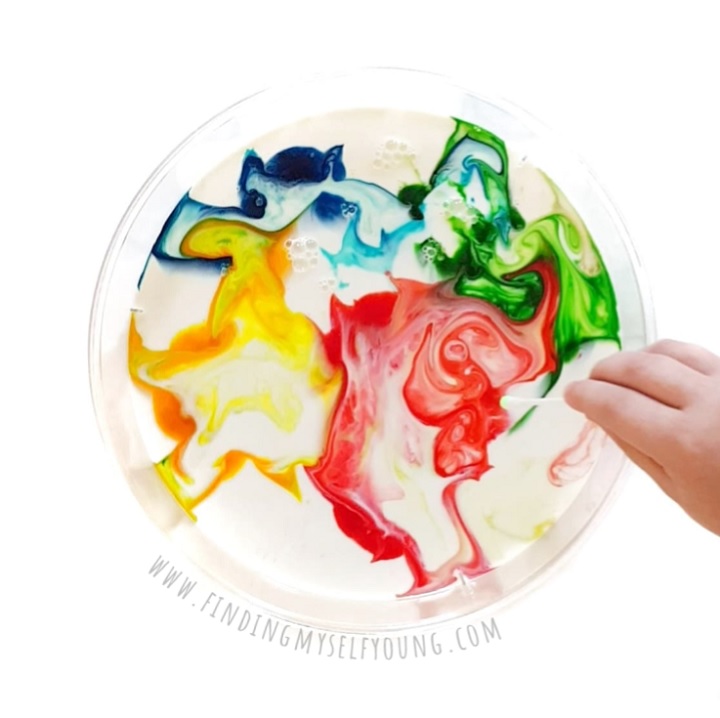If you want to introduce your kids to science concepts in a simple and interactive way then this magic milk science experiment is perfect!
Toddlers, preschoolers and even school children will be amazed watching the colours magically move across the milk. Best of all you can create this experiment with just four common household items you probably already have in your kitchen right now.
My daughter has been interested in science since she was quite little so we love to do simple science experiments at home. You don't need complicated equipment like microscopes, test tubes, Bunsen burners or dangerous chemicals to create science experiments at home.
There are so many simple science experiments that can be made with common household items that are both fascinating and fun. Magic milk is one of our favourite experiments to do at home because it seemingly turns science into magic right before your kids eyes.
SUPPLIES YOU'LL NEED
- Milk {full fat}
- Cotton buds {Q-tips}
- Dishwashing liquid
- Liquid food colouring
- Shallow dish or tray
We had everything we needed to do this experiment already on hand at home, but if you don't have everything you can find all of the items at your local supermarket. We did our experiment in a clear plant saucer, because it was the shallowest tray we had and I liked that it was clear, however any shallow dish or tray will work well. If your children are likely to splash in the milk then you may also want to use a plastic tablecloth or art smock.
HOW TO DO THE MAGIC MILK EXPERIMENT
The magic milk experiment is so easy to do older children can do it unassisted and younger children can do it with limited adult assistance. It's important to ensure children are supervised as you don't want them to accidentally consume the milk once the dishwashing liquid has been added {and also it can get messy quickly if a toddler decides to splash around in the milk}.
1. Fill the shallow tray with milk ensuring the whole tray is covered.
2. Drop a few drops of food colouring into the milk, leaving space between each drop.
3. Dip the end of a cotton bud into dishwashing liquid {you can use multiple cotton buds if you want a separate one for each drop of food colouring}.
4. Dip the cotton bud into the food colouring and watch the magic happen.
When we did the magic milk experiment we added four different drops of food colouring into the milk; blue, green, yellow and red. As my daughter dipped the cotton bud into each colour the food colouring repelled outwards from the detergent and the colours eventually became intertwined as they floated and moved about.
Watch the video further below to see how the colours danced about as the dishwashing liquid was dipped into them {she did go a bit crazy with it after a while}.
HOW DOES THE MAGIC MILK EXPERIMENT MAKE COLOURS MOVE?
While it may not require complex equipment, there's still a chemical reaction going on behind the scenes during the magic milk experiment. Milk is made up of water, vitamins, minerals, proteins and fats. When the dishwashing liquid touches the milk it reacts with the fats. The soap molecules from the dishwashing liquid are trying to attach to the fat molecules in the milk which causes movement in the liquid as the molecules in the fat and soap bond together and expel the water and food colouring.
Usually the chemical reaction occurring between the milk fats and the dishwashing liquid would not be visible to the naked eye {e.g. when you're washing up a cup that may have some milk residue in the bottom}, however the addition of the food colouring makes the movement from the reaction visible.
OTHER FUN SCIENCE EXPERIMENTS TO TRY AT HOME
To keep up to date with my latest posts and play activities you can sign up to my email list or follow me on Instagram, Pinterest & Facebook. I'd also love for you to join parents from all around the world in our Facebook community Finding Play Ideas.
Disclosure - This post contains some affiliate links for your convenience which means I may earn a small commission, at no cost to you, should you make a purchase.












Could I use 2% milk?
ReplyDeleteNo you'll need full fat milk for the reaction to occur.
Delete